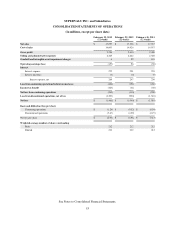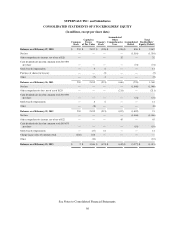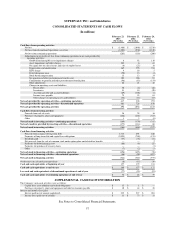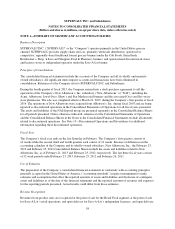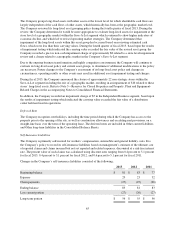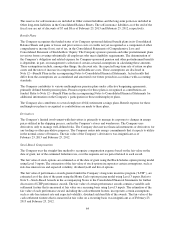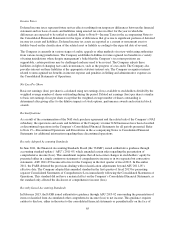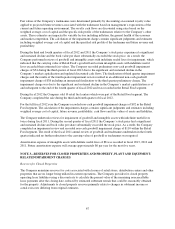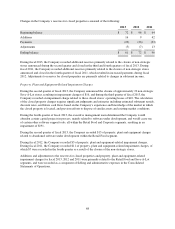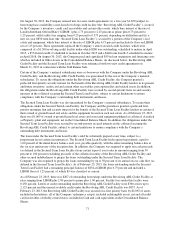Albertsons 2013 Annual Report Download - page 64
Download and view the complete annual report
Please find page 64 of the 2013 Albertsons annual report below. You can navigate through the pages in the report by either clicking on the pages listed below, or by using the keyword search tool below to find specific information within the annual report.Goodwill and Intangible Assets
Goodwill
The Company reviews goodwill for impairment during the fourth quarter of each year, and also if events occur or
circumstances change that would more-likely-than-not reduce the fair value of a reporting unit below its carrying
amount. The reviews consist of comparing estimated fair value to the carrying value at the reporting unit level.
The Company’s reporting units are the operating segments of the business which consist of Retail Food, Save-A-
Lot and Independent Business. As of February 23, 2013, Goodwill balances existed in the Save-A-Lot and
Independent Business reporting units. Fair values are determined by using both the market approach, applying a
multiple of earnings based on the guideline publicly traded company method, and the income approach,
discounting projected future cash flows based on management’s expectations of the current and future operating
environment. The rates used to discount projected future cash flows reflect a weighted average cost of capital
based on the Company’s industry, capital structure and risk premiums including those reflected in the current
market capitalization. If management identifies the potential for impairment of goodwill, the fair value of the
implied goodwill is calculated as the difference between the fair value of the reporting unit and the fair value of
the underlying assets and liabilities, excluding goodwill. An impairment charge is recorded for any excess of the
carrying value over the implied fair value.
The Company reviews the composition of its reporting units on an annual basis and on an interim basis if events
or circumstances indicate that the composition of the Company’s reporting units may have changed. There were
no changes in the Company’s reporting units as a result of the fiscal 2013 and 2012 reviews.
Intangible Assets
The Company also reviews intangible assets with indefinite useful lives, which primarily consist of trademarks
and tradenames, for impairment during the fourth quarter of each year, and also if events or changes in
circumstances indicate that the asset might be impaired. The reviews consist of comparing estimated fair value to
the carrying value. Fair values of the Company’s trademarks and tradenames are determined primarily by
discounting an assumed royalty value applied to management’s estimate of projected future revenues associated
with the tradename. The royalty cash flows are discounted using rates based on the weighted average cost of
capital discussed above and the specific risk profile of the tradenames relative to the Company’s other assets.
Refer to Note 2—Goodwill and Intangible Assets in the accompanying Notes to Consolidated Financial
Statements for the results of the goodwill and intangible assets with indefinite useful lives testing performed
during fiscal 2013, 2012 and 2011.
Impairment of Long-Lived Assets
The Company monitors the recoverability of its long-lived assets such as buildings and equipment, whenever
events or changes in circumstances indicate that the carrying amount of such assets may not be fully recoverable,
including current period losses combined with a history of losses or a projection of continuing losses, a
significant decrease in the market value of an asset or the Company’s plans for store closures. When such events
or changes in circumstances occur, a recoverability test is performed by comparing projected undiscounted future
cash flows to the carrying value of the group of assets being tested.
If impairment is identified for long-lived assets to be held and used, the fair value is compared to the carrying value
of the group of assets and an impairment charge is recorded for the excess of the carrying value over the fair value.
For long-lived assets that are classified as assets held for sale, the Company recognizes impairment charges for the
excess of the carrying value plus estimated costs of disposal over the estimated fair value. Fair value is based on
current market values or discounted future cash flows using Level 3 inputs. The Company estimates fair value based
on the Company’s experience and knowledge of the market in which the property is located and, when necessary,
utilizes local real estate brokers. The Company’s estimate of undiscounted cash flows attributable to the asset
groups included only future cash flows that are directly associated with and that are expected to arise as a direct
result of the use and eventual disposition of the asset group. Long-lived asset impairment charges are a component
of Selling and administrative expenses in the Consolidated Statements of Operations.
62



